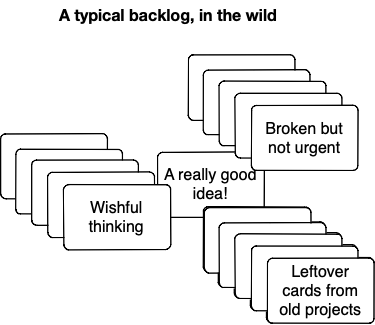Backlogs

Can’t live with ‘em, can’t live without ‘em🤷♂️
A product team (at least the ones that have been working for more than three weeks) has a backlog of work they’d love to tackle, but now’s not the right time. Maybe it’s not the most important, a practical solution isn’t in-hand, the technology isn’t ready yet, or a dependency hasn’t started work yet. Either way: a growing, somewhat discouraging list of things they want to do but can’t yet.
Over time, a backlog evolves to many forms. None of them are ideal. We have to look at backlogs for what they are: an artifact of time’s finite-ness and our finite ability to do work in the present.
A “big pile of sadness backlog” doesn’t acknowledge limitations in time and capacity. It imagines a future where we can do everything we’ve ever wanted. The backlog actually gets shorter. All those problems we once wanted to solve, we can. We are also a bit taller, more attractive, and feel a bit younger while we’re at it.
But that day never comes, and we’re left with a sad backlog of things. Almost (and this is the nefarious part) all of them less important than what we’re currently doing, but still, we think, important. So it stares at us from the shadows, a bit sad and discouraging us that we are failing at our job by having this large backlog of ideas and promising projects. At least we think they’re promising! More likely, in my experience, attempting to triage the pile of sadness backlog yield two more meta-projects around organizing the sadness to highlight the truly sad from the merely unfortunate. 😮💨
It’s more helpful to look at a backlog as numerous maybe-good ideas sent to our future-selves. By definition, a backlog is speculation. We thought executing on these projects and tasks would improve things, but we won’t know until we do. Schrödinger’s cat and all that. Storing all that speculation away in a pile is healthy. If it turns out one of these ideas is the right starting point for the next most important problem we face, we’ll pull it out of the backlog and give it a think. Otherwise, it stays there, putting no current work at risk.
The contents of a backlog are frozen in time. The tasks, projects, docs, designs, screenshots, diagrams, etc. all reflect a point in time. Some call this rot, implying “hey, we should have been better about keeping this campsite clean and used our (infinite 😜) time to tend it”. IMO that’s not the best approach; better to regard aging tasks as issues and solutions from a point of time. They may no longer reflect the circumstances the product and team currently face. Items in a backlog necessarily need updating by a PM or developer to figure out if they still make sense, would solve the problem, or are a direct solution to that problem.
I have quite the extended personal backlog of items to read and project ideas. When I regard them as missed opportunities, as evidence that I could have been at least a little more diligent in managing my time, it’s stressful and discouraging. When I instead regard it as a pile of ideas in reserve for mornings I wake up and none of my current hobby projects are enticing or what I’m reading isn’t doing it for me, then those backlogs are useful. Granted, said lists aren’t getting much shorter.
Perhaps, a backlog is a defense mechanism. They are, at times, a way to deliver a soft no, to ourselves or collaborators. “Not a bad idea, but not something we can get to right away. It’s in the backlog. Maybe someday we’ll come upon it.”
Or, you may have an impeccable backlog! All killer, no filler; like a “no-skips” album, but in product backlog form. If you’re out there, please let us know how you got here and how much effort it takes. 😆 (Really, if you’re out there, I’m intrigued!)
The flip side is no backlog at all. The project work is a river and if something interesting floats past, you seize upon it. Otherwise, you let it float downstream and don’t worry about it too much. Or, there’s no team backlog, but the team members keep a list of ideas/task/projects that might be interesting in the future and bring them up at opportune moments. That works too!